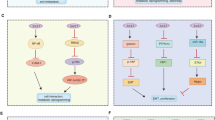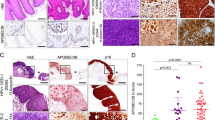Abstract
Human papillomaviruses (HPVs) are a causative factor in over 90% of cervical and 25% of head and neck squamous cell carcinomas (HNSCCs). The C terminus of the high-risk HPV 16 E6 oncoprotein physically associates with and degrades a non-receptor protein tyrosine phosphatase (PTPN13), and PTPN13 loss synergizes with H-RasV12 or ErbB2 for invasive growth in vivo. Oral keratinocytes that have lost PTPN13 and express H-RasV12 or ErbB2 show enhanced Ras/RAF/MEK/Erk signaling. In co-transfection studies, wild-type PTPN13 inhibited Ras/RAF/MEK/Erk signaling in HEK 293 cells that overexpress ErbB2, EGFR or H-RasV12, whereas an enzymatically inactive PTPN13 did not. Twenty percent of HPV-negative HNSCCs had PTPN13 phosphatase mutations that did not inhibit Ras/RAF/MEK/Erk signaling. Inhibition of Ras/RAF/MEK/Erk signaling using MEK inhibitor U0126 blocked anchorage-independent growth in cells lacking PTPN13. These findings show that PTPN13 phosphatase activity has a physiologically significant role in regulating MAP kinase signaling.
This is a preview of subscription content, access via your institution
Access options
Subscribe to this journal
Receive 50 print issues and online access
$259.00 per year
only $5.18 per issue
Buy this article
- Purchase on Springer Link
- Instant access to full article PDF
Prices may be subject to local taxes which are calculated during checkout






Similar content being viewed by others
References
Abaan OD, Toretsky JA . (2008). PTPL1: a large phosphatase with a split personality. Cancer Metastasis Rev 27: 205–214.
Adjei AA, Cohen RB, Franklin W, Morris C, Wilson D, Molina JR et al. (2008). Phase I pharmacokinetic and pharmacodynamic study of the oral, small-molecule mitogen-activated protein kinase kinase 1/2 inhibitor AZD6244 (ARRY-142886) in patients with advanced cancers. J Clin Oncol 26: 2139–2146.
Al Moustafa AE, Foulkes WD, Benlimame N, Wong A, Yen L, Bergeron J et al. (2004). E6/E7 proteins of HPV type 16 and ErbB-2 cooperate to induce neoplastic transformation of primary normal oral epithelial cells. Oncogene 23: 350–358.
Avila MA, Berasain C, Sangro B, Prieto J . (2006). New therapies for hepatocellular carcinoma. Oncogene 25: 3866–3884.
Barault L, Veyrie N, Jooste V, Lecorre D, Chapusot C, Ferraz JM et al. (2008). Mutations in the RAS-MAPK, PI(3)K (phosphatidylinositol-3-OH kinase) signaling network correlate with poor survival in a population-based series of colon cancers. Int J Cancer 122: 2255–2259.
Cavalot A, Martone T, Roggero N, Brondino G, Pagano M, Cortesina G . (2007). Prognostic impact of HER-2/neu expression on squamous head and neck carcinomas. Head Neck 29: 655–664.
Dromard M, Bompard G, Glondu-Lassis M, Puech C, Chalbos D, Freiss G . (2007). The putative tumor suppressor gene PTPN13/PTPL1 induces apoptosis through insulin receptor substrate-1 dephosphorylation. Cancer Res 67: 6806–6813.
Erdmann KS . (2003). The protein tyrosine phosphatase PTP-Basophil/Basophil-like. Interacting proteins and molecular functions. Eur J Biochem 270: 4789–4798.
Ford AC, Grandis JR . (2003). Targeting epidermal growth factor receptor in head and neck cancer. Head Neck 25: 67–73.
Hahn WC, Weinberg RA . (2002). Rules for making human tumor cells. N Engl J Med 347: 1593–1603.
Hanahan D, Weinberg RA . (2000). The hallmarks of cancer. Cell 100: 57–70.
Hardisson D . (2003). Molecular pathogenesis of head and neck squamous cell carcinoma. Eur Arch Otorhinolaryngol 260: 502–508.
Hoover AC, Spanos WC, Harris GF, Anderson ME, Klingelhutz AJ, Lee JH . (2007). The role of human papillomavirus 16 E6 in anchorage-independent and invasive growth of mouse tonsil epithelium. Arch Otolaryngol Head Neck Surg 133: 495–502.
Hopfner M, Schuppan D, Scherubl H . (2008). Growth factor receptors and related signalling pathways as targets for novel treatment strategies of hepatocellular cancer. World J Gastroenterol 14: 1–14.
Hsu J . (1992). The factor analytic approach to simultaneous inference in the general linear model. J Computational and Graphical Statistics 1: 151.
Jelen F, Oleksy A, Smietana K, Otlewski J . (2003). PDZ domains—common players in the cell signaling. Acta Biochim Pol 50: 985–1017.
Landro ME, Dalbert D, Picconi MA, Cuneo N, Gonzalez J, Vornetti S et al. (2008). Human papillomavirus and mutated H-ras oncogene in cervical carcinomas and pathological negative pelvic lymph nodes: a retrospective follow-up. J Med Virol 80: 694–701.
Lee JH, Lee SK, Yang MH, Ahmed MM, Mohiuddin M, Lee EY . (1996). Expression and mutation of H-ras in uterine cervical cancer. Gynecol Oncol 62: 49–54.
Longworth MS, Laimins LA . (2004). Pathogenesis of human papillomaviruses in differentiating epithelia. Microbiol Mol Biol Rev 68: 362–372.
Lorusso PM, Adjei AA, Varterasian M, Gadgeel S, Reid J, Mitchell DY et al. (2005). Phase I and pharmacodynamic study of the oral MEK inhibitor CI-1040 in patients with advanced malignancies. J Clin Oncol 23: 5281–5293.
Lu SL, Herrington H, Reh D, Weber S, Bornstein S, Wang D et al. (2006). Loss of transforming growth factor-beta type II receptor promotes metastatic head-and-neck squamous cell carcinoma. Genes Dev 20: 1331–1342.
Moasser MM . (2007). The oncogene HER2: its signaling and transforming functions and its role in human cancer pathogenesis. Oncogene 26: 6469–6487.
Nakahira M, Tanaka T, Robson BE, Mizgerd JP, Grusby MJ . (2007). Regulation of signal transducer and activator of transcription signaling by the tyrosine phosphatase PTP-BL. Immunity 26: 163–176.
Perez-Regadera J, Sanchez-Munoz A, De-la-Cruz J, Ballestin C, Lora D, Garcia-Martin R et al. (2009). Negative prognostic impact of the coexpression of epidermal growth factor receptor and c-erbB-2 in locally advanced cervical cancer. Oncology 76: 133–141.
Reddig PJ, Juliano RL . (2005). Clinging to life: cell to matrix adhesion and cell survival. Cancer Metastasis Rev 24: 425–439.
Revillion F, Puech C, Rabenoelina F, Chalbos D, Peyrat JP, Freiss G . (2009). Expression of the putative tumor suppressor gene PTPN13/PTPL1 is an independent prognostic marker for overall survival in breast cancer. Int J Cancer 124: 638–643.
Rinehart J, Adjei AA, Lorusso PM, Waterhouse D, Hecht JR, Natale RB et al. (2004). Multicenter phase II study of the oral MEK inhibitor, CI-1040, in patients with advanced non-small-cell lung, breast, colon, and pancreatic cancer. J Clin Oncol 22: 4456–4462.
Schreiber K, Cannon RE, Karrison T, Beck-Engeser G, Huo D, Tennant RW et al. (2004). Strong synergy between mutant ras and HPV16 E6/E7 in the development of primary tumors. Oncogene 23: 3972–3979.
Spanos WC, Geiger J, Anderson ME, Harris GF, Bossler AD, Smith RB et al. (2008a). Deletion of the PDZ motif of HPV16 E6 preventing immortalization and anchorage-independent growth in human tonsil epithelial cells. Head Neck 30: 139–147.
Spanos WC, Hoover A, Harris GF, Wu S, Strand GL, Anderson ME et al. (2008b). The PDZ binding motif of human papillomavirus type 16 E6 induces PTPN13 loss, which allows anchorage-independent growth and synergizes with ras for invasive growth. J Virol 82: 2493–2500.
Villa F, Deak M, Bloomberg GB, Alessi DR, van Aalten DM . (2005). Crystal structure of the PTPL1/FAP-1 human tyrosine phosphatase mutated in colorectal cancer: evidence for a second phosphotyrosine substrate recognition pocket. J Biol Chem 280: 8180–8187.
Wang D, Boerner SA, Winkler JD, LoRusso PM . (2007). Clinical experience of MEK inhibitors in cancer therapy. Biochim Biophys Acta 1773: 1248–1255.
Wang Z, Shen D, Parsons DW, Bardelli A, Sager J, Szabo S et al. (2004). Mutational analysis of the tyrosine phosphatome in colorectal cancers. Science 304: 1164–1166.
Wansink DG, Peters W, Schaafsma I, Sutmuller RP, Oerlemans F, Adema GJ et al. (2004). Mild impairment of motor nerve repair in mice lacking PTP-BL tyrosine phosphatase activity. Physiol Genomics 19: 50–60.
Yarbrough WG, Shores C, Witsell DL, Weissler MC, Fidler ME, Gilmer TM . (1994). ras mutations and expression in head and neck squamous cell carcinomas. Laryngoscope 104: 1337–1347.
Yeh SH, Wu DC, Tsai CY, Kuo TJ, Yu WC, Chang YS et al. (2006). Genetic characterization of fas-associated phosphatase-1 as a putative tumor suppressor gene on chromosome 4q21.3 in hepatocellular carcinoma. Clin Cancer Res 12: 1097–1108.
Ying J, Li H, Cui Y, Wong AH, Langford C, Tao Q . (2006). Epigenetic disruption of two proapoptotic genes MAPK10/JNK3 and PTPN13/FAP-1 in multiple lymphomas and carcinomas through hypermethylation of a common bidirectional promoter. Leukemia 20: 1173–1175.
Zhan M, Zhao H, Han ZC . (2004). Signalling mechanisms of anoikis. Histol Histopathol 19: 973–983.
Zhu JH, Chen R, Yi W, Cantin GT, Fearns C, Yang Y et al. (2008). Protein tyrosine phosphatase PTPN13 negatively regulates Her2/ErbB2 malignant signaling. Oncogene 27: 2525–2531.
Acknowledgements
JHL was supported by an NIDCR 1R01DE018386-01A1 and ACH was supported by an HHMI medical student fellowship. We acknowledge Jan Schepens’ technical expertise for completing the phosphatase assays and Catherine Christopherson for manuscript preparation.
Author information
Authors and Affiliations
Corresponding author
Additional information
Supplementary Information accompanies the paper on the Oncogene website (http://www.nature.com/onc)
Rights and permissions
About this article
Cite this article
Hoover, A., Strand, G., Nowicki, P. et al. Impaired PTPN13 phosphatase activity in spontaneous or HPV-induced squamous cell carcinomas potentiates oncogene signaling through the MAP kinase pathway. Oncogene 28, 3960–3970 (2009). https://doi.org/10.1038/onc.2009.251
Received:
Revised:
Accepted:
Published:
Issue Date:
DOI: https://doi.org/10.1038/onc.2009.251
Keywords
This article is cited by
-
Direct conversion of human umbilical cord mesenchymal stem cells into retinal pigment epithelial cells for treatment of retinal degeneration
Cell Death & Disease (2022)
-
PTPL1 suppresses lung cancer cell migration via inhibiting TGF-β1-induced activation of p38 MAPK and Smad 2/3 pathways and EMT
Acta Pharmacologica Sinica (2021)
-
β2-Adrenergic receptor modulates mitochondrial metabolism and disease progression in recurrent/metastatic HPV(+) HNSCC
Oncogenesis (2018)
-
Divergent viral presentation among human tumors and adjacent normal tissues
Scientific Reports (2016)
-
Genetic alterations of protein tyrosine phosphatases in human cancers
Oncogene (2015)



